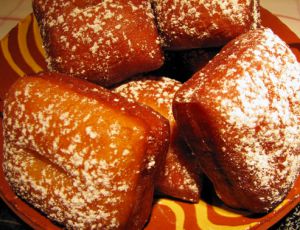Fastnachts (Pennsylvania Dutch/German Yeast Doughnuts)
http://teriskitchen.com/pa-dutch-recipes/fastnachts-yeast-doughnuts.htmlMakes 4 to 5 dozen doughnuts
Fastnacht Day is a special Pennsylvania Dutch celebration that falls on Shrove Tuesday, the day before Ash Wednesday. The word translates to 'Fast Night'. The tradition is to eat the very best, and lots of it, before the Lenten fast. Fastnachts (pronounced fost-nokts) are doughnuts. There are three types of Fastnachts, one made with yeast, one made with baking powder, and one made with potatoes and yeast. All are slightly crispy on the outside and not as sweet as standard doughnuts. My family usually had crullers, which do not use yeast. I have recipes for both the yeast Fastnachts, as in this recipe, and crullers, a less time-consuming doughnut and my personal favorite. A cousin shared her family's recipe for potato Fastnachts, but I have not tried it as yet. Both of those recipes are in the similar and related recipes. Traditionally, all Fastnachts were made with, and fried in, lard. I have altered that in the recipes since it is so difficult to find nowadays but, if you can find it, lard would be the first choice.
Ingredients
Sponge
- 2 cups milk, room temperature
- 1 package (2-1/4 teaspoons) rapid-rise dry yeast
- 1/4 cup lukewarm water
- 1 teaspoon granulated sugar
- 3 cups all-purpose flour
- 2 large eggs, room temperature
- 1/3 cup vegetable shortening (preferably non-hydrogenated)
- 3 cups all-purpose flour, more if needed
- 1 teaspoon salt
- 1 teaspoon ground mace
- 3/4 cup granulated sugar
- Vegetable or canola oil for frying, about 2 quarts
For the sponge: Scald the milk and cool. (This can be done in a pan on the stovetop, or in a bowl in the microwave on High for about 3 minutes, depending on wattage. Heat but do not boil.) Dissolve the yeast in the water and let rest until it starts to bubble to make certain it is alive. Place the milk, 1 teaspoon sugar, 3 cups flour and yeast mixture in a large bowl of an electric mixer. Stir on low just until combined. Cover and let rise in a draft-free area until doubled, about 30 minutes.
For the dough: Beat the eggs in a small bowl. Melt the shortening and let cool. Place 3 cups of the remaining flour in a medium bowl. Add the salt and mace; stir with a whisk to combine. When the sponge has doubled, add the eggs, melted shortening and the 3/4 cup sugar; stir just to combine. On the lowest setting of the mixer, add the flour mixture, about one-third at a time. Stir just to combine. Do not over mix. The dough should be very soft and just dry enough to roll. If it is very sticky, incorporate just a little more flour, about 2 tablespoons at a time. Cover and let rise until doubled, 1-1/2 to 2 hours.
When doubled, place dough on a lightly floured surface. Gently roll to about 1/2-inch thickness, as close to a square or rectangle as possible. Cut into 2-inch squares. If desired, cut a slit down the center of each square, being careful not to go all the way through the dough. (This is traditional for Fastnachts. Supposedly, it makes them crispier all over the outside. However, it is not necessary.) Place on large baking sheets lined with parchment or waxed paper. Cover and let rise again until nearly doubled, about 1-1/2 to 2 hours.
To fry doughnuts: Place the oil in a deep pan high enough to hold the oil half way up the sides. Heat to 360° over medium heat. Carefully fry the doughnuts, about 5 to 7 at a time, until well-browned on one side, about 3 minutes. Flip to other side and brown another 3 minutes. Remove from oil and drain on paper towels.
Notes: I like to use my stand-up mixer, but these are relatively easy to make by hand. Doughnuts may be sprinkled with granulated or confectioner's sugar while still warm. The PA Dutch tradition is to cut open the doughnut horizontally, and drizzle the cut sides with molasses. I prefer them plain. They are best served the same day because they are so good when crispy on the outside. However, they are still good, stored in plastic bags in the refrigerator for up to a week, or in the freezer for several months. Leftover Fastnachts are best placed in a preheated 350° oven for about 5 minutes to recrisp slightly. Watch them carefully to prevent burning.
 http://teriskitchen.com
http://teriskitchen.com